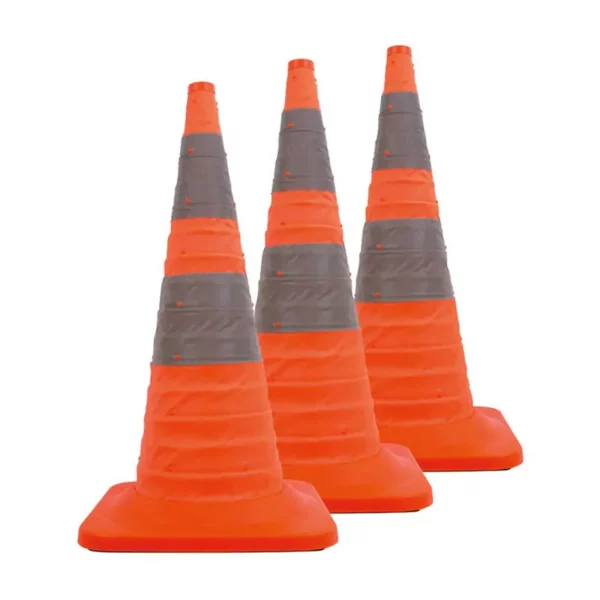Folding traffic cones come in various sizes, typically ranging from smaller, more compact options to larger, more visible cones. The sizes often correspond to their intended use and portability. Here are some common sizes available:
Small Sizes:
- 12 inches (30 cm): Compact cones suitable for personal use, such as in small parking areas or temporary personal traffic guidance.
Medium Sizes:
- 18 inches (45 cm): Intermediate size cones suitable for light to moderate traffic control in small to medium-sized areas like parking lots or construction sites.
Standard Sizes:
- 28 inches (70 cm) to 36 inches (90 cm): Standard-sized cones suitable for general traffic control, construction zones, and roadwork areas.
Large Sizes:
- 40 inches (1 meter) and above: Larger cones used for highway or heavy traffic control, often in more extensive construction or roadwork areas.
Adjustable Height:
- Telescopic Cones: Some folding cones are adjustable in height, allowing for flexibility in various situations, typically ranging from smaller to standard sizes.
The selection of the appropriate cone size depends on the intended use, visibility needs, and the level of traffic control required in specific areas. folding traffic cone Smaller cones offer more portability and are suitable for lighter traffic or personal use, while larger cones provide better visibility and are more suitable for high-traffic areas or larger construction zones.
How do folding traffic cone help with traffic management?
Folding traffic cones aid traffic management in several ways:
Temporary Guidance:
- Quick Deployment: They can be easily set up and removed, providing temporary guidance during road repairs, accidents, or events.
Visibility Enhancement:
- Increased Visibility: These cones offer high visibility, alerting drivers to changes in traffic patterns or potential hazards.
Traffic Channeling:
- Lane Delineation: Cones help delineate lanes, directing traffic flow around obstacles or toward designated routes.
Hazard Warning:
- Alerting to Hazards: They signal drivers about potential dangers or blocked areas, improving safety and preventing accidents.
Temporary Marking:
- Temporary Barriers: Cones create temporary barriers, restricting access to specific areas or creating safe zones for pedestrians.
Flexibility in Use:
- Versatile Deployment: They can be used in various settings, including construction sites, parking lots, or emergency situations.
Portability:
- Easy Transportation: Being collapsible or foldable, these cones are portable and convenient to transport to different locations.
Emergency Situations:
- Emergency Control: They aid in managing traffic during emergencies, ensuring order and safety during critical situations.
Traffic Control Planning:
- Planning Aid: Cones assist in planning traffic flow, providing a flexible tool for traffic control based on changing needs.
Compliance with Standards:
- Meeting Regulations: Folding traffic cones comply with traffic safety regulations, ensuring proper traffic management practices.
Reducing Traffic Congestion:
- Managing Flow: These cones help manage traffic flow, reducing congestion and ensuring smoother movement in specific areas.
Quick Identification:
- Clear Markers: They offer clear markers for drivers, indicating specific directions or warnings swiftly.
Folding traffic cones play a crucial role in traffic management by providing clear guidance, enhancing visibility, and ensuring safer navigation for drivers in various temporary or changing traffic conditions.
